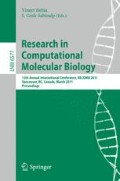Abstract
Genomic distance between two genomes, i.e., the smallest number of genome rearrangements required to transform one genome into the other, is often used as a measure of evolutionary closeness of the genomes in comparative genomics studies. However, in models that include rearrangements of significantly different “power” such as reversals (that are “weak” and most frequent rearrangements) and transpositions (that are more “powerful” but rare), the genomic distance typically corresponds to a transformation with a large proportion of transpositions, which is not biologically adequate.
Weighted genomic distance is a traditional approach to bounding the proportion of transpositions by assigning them a relative weight α > 1. A number of previous studies addressed the problem of computing weighted genomic distance with α ≤ 2.
Employing the model of multi-break rearrangements on circular genomes, that captures both reversals (modelled as 2-breaks) and transpositions (modelled as 3-breaks), we prove that for α ∈ (1,2], a minimum-weight transformation may entirely consist of transpositions, implying that the corresponding weighted genomic distance does not actually achieve its purpose of bounding the proportion of transpositions. We further prove that for α ∈ (1,2), the minimum-weight transformations do not depend on a particular choice of α from this interval. We give a complete characterization of such transformations and show that they coincide with the transformations that at the same time have the shortest length and make the smallest number of breakages in the genomes.
Our results also provide a theoretical foundation for the empirical observation that for α < 2, transpositions are favored over reversals in the minimum-weight transformations.
Access this chapter
Tax calculation will be finalised at checkout
Purchases are for personal use only
Preview
Unable to display preview. Download preview PDF.
References
Alekseyev, M.A.: Multi-Break Rearrangements and Breakpoint Re-uses: from Circular to Linear Genomes. Journal of Computational Biology 15(8), 1117–1131 (2008)
Alekseyev, M.A., Pevzner, P.A.: Are There Rearrangement Hotspots in the Human Genome? PLoS Computational Biology 3(11), e209 (2007)
Alekseyev, M.A., Pevzner, P.A.: Multi-Break Rearrangements and Chromosomal Evolution. Theoretical Computer Science 395(2-3), 193–202 (2008)
Bader, M., Ohlebusch, E.: Sorting by weighted reversals, transpositions, and inverted transpositions. Journal of Computational Biology 14(5), 615–636 (2007)
Bafna, V., Pevzner, P.A.: Genome rearrangements and sorting by reversals. SIAM Journal on Computing 25, 272–289 (1996)
Blanchette, M., Kunisawa, T., Sankoff, D.: Parametric genome rearrangement. Gene 172(1), GC11–GC17 (1996)
Christie, D.A.: Sorting permutations by block-interchanges. Information Processing Letters 60(4), 165–169 (1996)
Elias, I., Hartman, T.: A 1.375-approximation algorithm for sorting by transpositions. IEEE/ACM Transactions on Computational Biology and Bioinformatics 3, 369–379 (2006)
Eriksen, N.: (1 + ε)-Approximation of Sorting by Reversals and Transpositions. In: Gascuel, O., Moret, B.M.E. (eds.) WABI 2001. LNCS, vol. 2149, pp. 227–237. Springer, Heidelberg (2001)
Fertin, G., Labarre, A., Rusu, I., Tannier, E.: Combinatorics of Genome Rearrangements. The MIT Press, Cambridge (2009)
Hannenhalli, S., Pevzner, P.: Transforming men into mouse (polynomial algorithm for genomic distance problem). In: Proceedings of the 36th Annual Symposium on Foundations of Computer Science, pp. 581–592 (1995)
Hannenhalli, S., Pevzner, P.A.: Transforming Cabbage into Turnip (polynomial algorithm for sorting signed permutations by reversals). In: Proceedings of the 27th Annual ACM Symposium on the Theory of Computing, pp. 178–189 (1995); full version appeared in Journal of ACM 46, 1–27 (1995)
Radcliffe, A.J., Scott, A.D., Wilmer, E.L.: Reversals and Transpositions Over Finite Alphabets. SIAM J. Discrete Math. 19, 224–244 (2005)
Yancopoulos, S., Attie, O., Friedberg, R.: Efficient sorting of genomic permutations by translocation, inversion and block interchange. Bioinformatics 21, 3340–3346 (2005)
Author information
Authors and Affiliations
Editor information
Editors and Affiliations
Rights and permissions
Copyright information
© 2011 Springer-Verlag Berlin Heidelberg
About this paper
Cite this paper
Jiang, S., Alekseyev, M.A. (2011). Weighted Genomic Distance Can Hardly Impose a Bound on the Proportion of Transpositions. In: Bafna, V., Sahinalp, S.C. (eds) Research in Computational Molecular Biology. RECOMB 2011. Lecture Notes in Computer Science(), vol 6577. Springer, Berlin, Heidelberg. https://doi.org/10.1007/978-3-642-20036-6_13
Download citation
DOI: https://doi.org/10.1007/978-3-642-20036-6_13
Publisher Name: Springer, Berlin, Heidelberg
Print ISBN: 978-3-642-20035-9
Online ISBN: 978-3-642-20036-6
eBook Packages: Computer ScienceComputer Science (R0)

